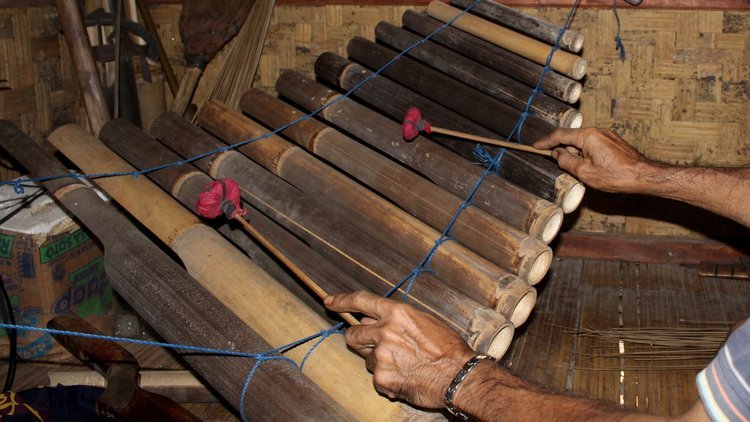Suspended Traditions: A Calung Renteng Addendum
Sound: Calung renteng (also known as calung rantay)
Location: Ds. Sukamulya, Kec. Leles, Kab. Cianjur, West Java
The rural hinterlands of West Java are full of musical surprises. Some of my favorite are modern performance traditions still brimming with youthful energy, like the bajidoran-esque all-night frame drum-filled dance parties of bangpret in Subang, or the wailing clarinets and dancing horse parades of tanji in Sumedang. The other flavor is of the buhun (“ancient” in Sundanese) variety: instrumental and vocal traditions dating back hundreds if not thousands of years, traditions surveyed by Dutch ethnomusicologist Jaap Kunst in the 20’s and noted as being on their way out. Think the raw yodel-like field cries of beluk, or the sacred tarawangsa duo with its ties to the rice harvest and ancestor worship.
One such living relic has lured me back to share a rare sequel, Calung Pt. 2: Return of the Hanging Xylophone. Back in 2017, fresh from an exciting trip to visit the Baduy people of Banten in far West Java, I reported back with a post on calung renteng, a hanging bamboo xylophone whose music I’d never heard recorded. At the time, I’d already undertaken a survey of similar hanging calung traditions across West Java and deemed them almost completely lost to time: I remember a particular day back in 2014 scootering around the village of Banjaran, now a sprawling suburb of South Bandung, desperately looking for the remnants of a calung renteng tradition recorded by local bureaucrats in a regional inventory of arts undertaken decades prior. I came up empty handed that time: most folks had no idea what I was even talking about.
Calung renteng as played by the Baduy Luar of Banten.
After that 2017 post, my preoccupation with calung was momentarily suspended. I moved away from the Sundanese heartland of West Java, went on dozens of other trips to other islands. Still, the instrument would organically return to my life: in 2019, I stumbled upon the klongkopak, a version of the hanging bamboo xylophone played by the Dayak Deah of South Kalimantan. Other ethnomusicologist friends pointed out the ubiquity of similar hanging bamboo xylophones across Southeast Asia, from the t’rung of highland Vietnam to the tak keung of nearby northeast Cambodia. The wide spread and nearly identical construction of these instruments made me realize that this is likely an instrumental format with truly deep roots.
This past October, I returned to West Java for a long stay, the first time in years. I’d set up camp in urban Bandung, but the countryside and its myriad musical treasures soon beckoned to me, and I was on the road again: to tarawangsa rituals in Sumedang and angklung buncis recording sessions near the southern coast (more on that soon!) One trip took me to Leles, a district in the south of Cianjur which quickly revealed itself to be incredibly remote: it was an undertaking even to get to the place, a seven hour journey on motorbike from Bandung down increasingly slippery roads until eventually I was bumping along for miles on nothing but muddy farmers’ paths and rivers of rock that only theoretically functioned to take a person from Point A to Point B.
What I found in Leles was a corner of rural West Java where ancient musical traditions have, against all odds, persevered. My main destination was the village of Rawasalak, where I was to record goong renteng, an ancient form of gamelan still played in less than a dozen villages across all of West Java. That was exciting enough (and will also be shared in a future post!), but soon locals were telling me of other musical treasures: tarawangsa, that sacred fiddle and zither duo often thought to only survive in far-off Sumedang, is still played in these parts of harvest rituals - a completely undocumented instance of this ancient performance tradition. And then, finally, there was one more surprise: calung renteng.
On my second day in Leles, my friend Agus shuttled me over those brutal rivers of rock to the village of Sukamulya, where we both had heard there were still old-timers around keeping the calung renteng tradition alive. We were directed to the home of Pak Adeng, a man with albinism living alone in a humble house on stilts with woven bamboo walls. Pak Adeng greeted us and politely excused himself for the Friday prayer; when he returned, it was with a canvas sack that clattered with the sound of bamboo.
Inviting us into his spartan living room, Pak Adeng delicately unsheathed a tangle of bamboo keys and rope and instantly set to hanging it up as a curious kitten bounced between his legs. One end of the xylophone was anchored to a tab of bamboo wedged into the bamboo lattice of the wall, then the instrument was draped down to meet the second anchor on the far end: Pak Adeng’s outstretched toe! As Pak Adeng began to tap out rhythms on the keys with spoon-like wooden mallets, I noticed that his position when playing matched that of the Baduy calung renteng, with the keys arranged horizontally from left to right in front of the player rather than vertically/extending away from the player as in calung renteng elsewhere (Banten, South Tasikmalaya.)
Calung renteng as played elsewhere in West Java and Banten.
Pak Adeng’s arrangements and performance of the pieces instantly struck me as something special, though, quite different from the calung I’d recorded before. While the Baduy calung renteng style had seemed indebted to techniques borrowed from the gambang (the wooden xylophone used in many gamelan ensembles) like parallel movement in both hands along the octaves, Pak Adeng’s calung felt freer, as if you could see and hear all those accumulated hours of play and experimentation afforded in the audience-free venue of the rice fields. Often his left hand would settle on a rhythmic ostinato while his right wandered up the scales playing bubbling melodies in accompaniment. All the while, the kitten tugged at the loose rope dangling from Pak Adeng’s toe, an adorable distraction that just amplified the relaxed, domestic vibe of the musical environment.
The pieces that Pak Adeng summoned were a mix of song forms found across West Java, like “Pangapungan,” and pieces that seemed to be local specialties, from “Pingping Koneng” (Sundanese for “yellow thigh,” “like a woman’s,” Pak Adeng confirmed with a shy laugh) to “Ulen Tutung” (named after a sticky rice treat) and “Tingti Tingtong” (pure onomatopoeia!) I’d only asked for a sample, but Pak Adeng played on, telling me that he had at least thirty songs under his belt, almost all of them a special repertoire just for calung.
As Pak Adeng made his way through “Tingti Tingtong,” a skinny, darker-skinned man with greying hair and a handful of teeth shuffle into the houses. This, we learned, was Pak Dana, Adeng’s older brother, and he wanted to join! In an unexpected twist, we learned that the 14-keyed calung that Pak Adeng had been playing was but one of a pair, often played together with a smaller nine-keyed one, the calung anak (child calung) to the larger calung induk (mother calung.) Happy to see this unique format, we reshuffled a bit to make room for Pak Dana and searched out another spot on the wall from which to hang his instrument. Once both were settled in, they played a number of pieces together. Rather than playing an interlocking part as you might expect here in Java, Pak Dana merely followed along with his younger brother, with a simplified version of his brother’s part in unison , a sour sound in the air as the mysteriously out-of-tune calung anak clashed with its elder.
This is not music that’s going to draw massive crowds or set the Indonesian folk music world on fire, but in some ways, that’s really part of the charm. Indonesia was once full of rural traditions like this, unpretentious music played for an audience of birds and fellow farmers and no one else, music played in field-side bamboo huts rather than on a stage in front of a crowd. With industrialization, urbanization, even shifts in farming techniques, these traditions have often faded away, especially as the unshowy simplicity of the music doesn’t lend itself to government-led revival efforts that focus on spectacle and literally “staged” performances. It’s likely that calung renteng was once common all across West Java, but has simply faded out elsewhere. This area’s remoteness is a major challenge for the folks who live there and must struggle with the unpaved roads and lack of basic utilities (the government electrical grid just showed up a few years ago!), but its likely that this very remoteness is what allows these rural traditions to hold on, miraculously, for just a little bit longer.
***
Special thanks to the wonderful musicians, Pak Adeng and Pak Dana, and to my friend and local guide Kang Agus for accompanying and helping with Sundanese translation. An extra nuhun for Ilham Nurwansyah for extra translation help!






